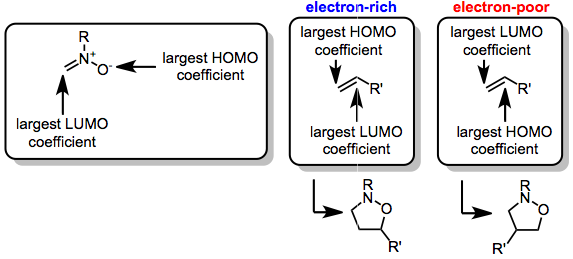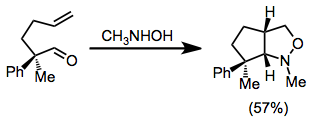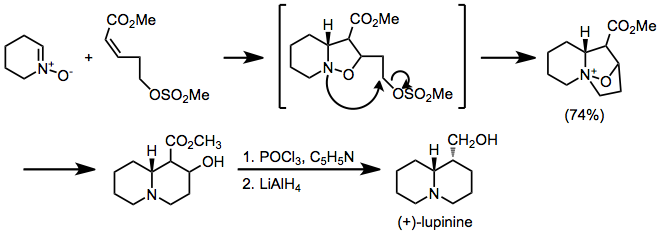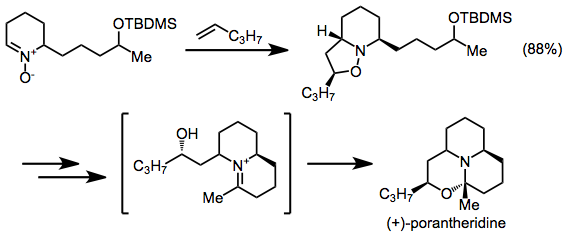Nitrone-olefin (3 2) Cycloaddition on:
[Wikipedia]
[Google]
[Amazon]
The nitrone-olefin (3+2) cycloaddition reaction is the combination of a
 The +2cycloaddition itself is a concerted,
pericyclic process whose regiochemistry is
controlled by the frontier molecular orbitals on
the nitrone (the dipole) and the dipolarophile.
When R' is an electron-donating group, alkyl,
or aryl, the dominant FMOs are the HOMO of
the dipolarophile and the LUMO of the nitrone.
Thus, connecting the atoms whose coefficients
in these orbitals are largest, the 5-substituted
isoxazolidine is predicted to predominate. On
the other hand, when the dipolarophile is electron poor,
the HOMOnitrone-LUMOdipolarophile
interaction is most important, and the 4-substituted
product is favored.
The +2cycloaddition itself is a concerted,
pericyclic process whose regiochemistry is
controlled by the frontier molecular orbitals on
the nitrone (the dipole) and the dipolarophile.
When R' is an electron-donating group, alkyl,
or aryl, the dominant FMOs are the HOMO of
the dipolarophile and the LUMO of the nitrone.
Thus, connecting the atoms whose coefficients
in these orbitals are largest, the 5-substituted
isoxazolidine is predicted to predominate. On
the other hand, when the dipolarophile is electron poor,
the HOMOnitrone-LUMOdipolarophile
interaction is most important, and the 4-substituted
product is favored.

 The configuration of 1,2-disubstituted alkenes is maintained in the products of cycloaddition. Consistent with FMO control of the reaction, the more electron-withdrawing substituent on these substrates ends up in the 4 position of the product. Put another way, the carbon with the largest LUMO coefficient in the dipolarophile (distant from the electron-withdrawing group) forms a bond with the nitrone oxygen, which possesses the largest HOMO coefficient in the nitrone.
The configuration of 1,2-disubstituted alkenes is maintained in the products of cycloaddition. Consistent with FMO control of the reaction, the more electron-withdrawing substituent on these substrates ends up in the 4 position of the product. Put another way, the carbon with the largest LUMO coefficient in the dipolarophile (distant from the electron-withdrawing group) forms a bond with the nitrone oxygen, which possesses the largest HOMO coefficient in the nitrone.
 Alkynes can also serve as dipolarophiles in this reaction. The rules for predicting alkene cycloaddition products based on the relevant FMOs apply to substituted alkynes as well—electron-poor alkynes tend to give 4-substituted products, while electron-rich, alkyl, and aryl alkynes give 5-substituted products.
Alkynes can also serve as dipolarophiles in this reaction. The rules for predicting alkene cycloaddition products based on the relevant FMOs apply to substituted alkynes as well—electron-poor alkynes tend to give 4-substituted products, while electron-rich, alkyl, and aryl alkynes give 5-substituted products.
 Intramolecular variants of the reaction are very useful for the synthesis of complex polycyclic frameworks. These reactions generally take place at much lower temperatures than intermolecular cycloadditions. Regiochemistry is more difficult to predict for intramolecular reactions: either bridged or fused products can result, and both ''cis''- and ''trans''-fused rings are possible.
Intramolecular variants of the reaction are very useful for the synthesis of complex polycyclic frameworks. These reactions generally take place at much lower temperatures than intermolecular cycloadditions. Regiochemistry is more difficult to predict for intramolecular reactions: either bridged or fused products can result, and both ''cis''- and ''trans''-fused rings are possible.
 An existing stereocenter in the tether between the alkene and nitrone often leads to the generation of a single diastereomer of product. In this example, the bulkier phenyl substituent ends up on the ''exo'' face of the bicyclic ring system.
An existing stereocenter in the tether between the alkene and nitrone often leads to the generation of a single diastereomer of product. In this example, the bulkier phenyl substituent ends up on the ''exo'' face of the bicyclic ring system.




Article
/ref>
nitrone
In organic chemistry, a nitrone is a functional group consisting of an ''N''-oxide of an imine. The general structure is , where R’ is not a hydrogen. A nitrone is a 1,3-dipole, and is used in 1,3-dipolar cycloadditions. Other reactions of ...
with an alkene
In organic chemistry, an alkene is a hydrocarbon containing a carbon–carbon double bond.
Alkene is often used as synonym of olefin, that is, any hydrocarbon containing one or more double bonds.H. Stephen Stoker (2015): General, Organic, an ...
or alkyne
\ce
\ce
Acetylene
\ce
\ce
\ce
Propyne
\ce
\ce
\ce
\ce
1-Butyne
In organic chemistry, an alkyne is an unsaturated hydrocarbon containing at least one carbon—carbon triple bond. The simplest acyclic alkynes with only one triple bond and n ...
to generate an isoxazoline
Isoxazolines are a class of five-membered heterocyclic chemical compounds, containing one atom each of oxygen and nitrogen which are located adjacent to one another. The ring was named in-line with the Hantzsch–Widman nomenclature. They are stru ...
or isoxazolidine
An oxazolidine is a five-membered ring compound consisting of three carbon atoms, a nitrogen atom and an oxygen atom. The O atom and NH group are the 1 and 3 positions, respectively. In oxazolidine derivatives, there is always a carbon atom betwee ...
via a +2cycloaddition
In organic chemistry, a cycloaddition is a chemical reaction in which "two or more Unsaturated hydrocarbon, unsaturated molecules (or parts of the same molecule) combine with the formation of a cyclic adduct in which there is a net reduction of th ...
process. This reaction is a 1,3-dipolar cycloaddition, in which the nitrone acts as the 1,3-dipole
In organic chemistry, a 1,3-dipolar compound or 1,3-dipole is a dipolar compound with delocalized electrons and a separation of charge over three atoms. They are reactants in 1,3-dipolar cycloadditions.
The dipole has at least one resonance st ...
, and the alkene or alkyne as the dipolarophile.
Mechanism and stereochemistry
When nitrones are combined with either alkenes or alkynes, +2cycloaddition leads to the formation of a new C–C bond and a new C–O bond. The cycloadditions is stereospecific with respect to the configuration of the alkene; however, diastereoselectivity in reactions of C-substituted nitrones is often low. Regioselectivity is controlled by the dominant frontier orbitals interacting during the reaction, and substrates with electronically distinct substituents tend to react with high regioselectivity. Intramolecular versions of the reaction have been used to synthesize complex polyclic carbon frameworks. Reduction of the N–O linkage leads to 1,3-aminoalcohols. The +2cycloaddition itself is a concerted,
pericyclic process whose regiochemistry is
controlled by the frontier molecular orbitals on
the nitrone (the dipole) and the dipolarophile.
When R' is an electron-donating group, alkyl,
or aryl, the dominant FMOs are the HOMO of
the dipolarophile and the LUMO of the nitrone.
Thus, connecting the atoms whose coefficients
in these orbitals are largest, the 5-substituted
isoxazolidine is predicted to predominate. On
the other hand, when the dipolarophile is electron poor,
the HOMOnitrone-LUMOdipolarophile
interaction is most important, and the 4-substituted
product is favored.
The +2cycloaddition itself is a concerted,
pericyclic process whose regiochemistry is
controlled by the frontier molecular orbitals on
the nitrone (the dipole) and the dipolarophile.
When R' is an electron-donating group, alkyl,
or aryl, the dominant FMOs are the HOMO of
the dipolarophile and the LUMO of the nitrone.
Thus, connecting the atoms whose coefficients
in these orbitals are largest, the 5-substituted
isoxazolidine is predicted to predominate. On
the other hand, when the dipolarophile is electron poor,
the HOMOnitrone-LUMOdipolarophile
interaction is most important, and the 4-substituted
product is favored.

Scope and limitations
Alkyl and aryl terminal alkenes react with high regioselectivity to give 5-substituted isoxazolidines. This outcome is consistent with frontier molecular orbital (kinetic) control of the distribution of isomers: the nitrone oxygen, which possesses the largest orbital coefficient in the HOMO of the nitrone, forms a bond with the inner carbon of the alkene, which possesses the largest orbital coefficient in the LUMO of the alkene. The configuration of 1,2-disubstituted alkenes is maintained in the products of cycloaddition. Consistent with FMO control of the reaction, the more electron-withdrawing substituent on these substrates ends up in the 4 position of the product. Put another way, the carbon with the largest LUMO coefficient in the dipolarophile (distant from the electron-withdrawing group) forms a bond with the nitrone oxygen, which possesses the largest HOMO coefficient in the nitrone.
The configuration of 1,2-disubstituted alkenes is maintained in the products of cycloaddition. Consistent with FMO control of the reaction, the more electron-withdrawing substituent on these substrates ends up in the 4 position of the product. Put another way, the carbon with the largest LUMO coefficient in the dipolarophile (distant from the electron-withdrawing group) forms a bond with the nitrone oxygen, which possesses the largest HOMO coefficient in the nitrone.
 Alkynes can also serve as dipolarophiles in this reaction. The rules for predicting alkene cycloaddition products based on the relevant FMOs apply to substituted alkynes as well—electron-poor alkynes tend to give 4-substituted products, while electron-rich, alkyl, and aryl alkynes give 5-substituted products.
Alkynes can also serve as dipolarophiles in this reaction. The rules for predicting alkene cycloaddition products based on the relevant FMOs apply to substituted alkynes as well—electron-poor alkynes tend to give 4-substituted products, while electron-rich, alkyl, and aryl alkynes give 5-substituted products.
 Intramolecular variants of the reaction are very useful for the synthesis of complex polycyclic frameworks. These reactions generally take place at much lower temperatures than intermolecular cycloadditions. Regiochemistry is more difficult to predict for intramolecular reactions: either bridged or fused products can result, and both ''cis''- and ''trans''-fused rings are possible.
Intramolecular variants of the reaction are very useful for the synthesis of complex polycyclic frameworks. These reactions generally take place at much lower temperatures than intermolecular cycloadditions. Regiochemistry is more difficult to predict for intramolecular reactions: either bridged or fused products can result, and both ''cis''- and ''trans''-fused rings are possible.
 An existing stereocenter in the tether between the alkene and nitrone often leads to the generation of a single diastereomer of product. In this example, the bulkier phenyl substituent ends up on the ''exo'' face of the bicyclic ring system.
An existing stereocenter in the tether between the alkene and nitrone often leads to the generation of a single diastereomer of product. In this example, the bulkier phenyl substituent ends up on the ''exo'' face of the bicyclic ring system.

Synthetic applications
Synthesis of (±)-lupinine
2,3,4,5-Tetrahydropyridine-1-oxide can be used for the construction of fused heterocycles in alkaloids and other natural products. A synthesis of (±)-lupinine
Lupinine is a quinolizidine alkaloid present in the genus ''Lupinus'' (colloquially referred to as lupins) of the flowering plant family Fabaceae. The scientific literature contains many reports on the isolation and synthesis of this compound as ...
uses a ring-expanding
rearrangement of a mesylate, providing rapid access to the target.

Synthesis of hydroxycotinine
The structure of hydroxycotinine, a human metabolite of nicotine, was confirmed via an independent synthesis employing nitrone-olefin cycloaddition.
Synthesis of (+)-porantheridine
Rearrangement of a +2cycloadduct provides (+)-porantheridine. The cycloadduct is subjected to hydrogenation, acid hydrolysis, oxidation, basic hydrolysis, and cyclization to give the target.
Kinugasa reaction to form β-lactams
In the Kinugasa reaction, a nitrone and acopper
Copper is a chemical element with the symbol Cu (from la, cuprum) and atomic number 29. It is a soft, malleable, and ductile metal with very high thermal and electrical conductivity. A freshly exposed surface of pure copper has a pinkis ...
acetylide
In organometallic chemistry, acetylide refers to chemical compounds with the chemical formulas and , where M is a metal. The term is used loosely and can refer to substituted acetylides having the general structure (where R is an organic side c ...
react to ultimately form a β-lactam
A beta-lactam (β-lactam) ring is a four-membered lactam. A ''lactam'' is a cyclic amide, and ''beta''-lactams are named so because the nitrogen atom is attached to the Β carbon, β-carbon atom relative to the carbonyl. The simplest β-lactam p ...
. In the first step of this reaction, a metal acetylide is formed by reaction of the terminal alkyne with the copper salt. The 1,3-dipolar cycloaddition of the nitrone with the metal acetylide affords a 5-membered ring that rearranges to form a β-lactam.
Other reactions
Another example of a +2cycloaddition is that in which a Baylis-Hillman adduct is the dipolarophile. This reacts with C-phenyl-N-methylnitrone to form anisoxazolidine
An oxazolidine is a five-membered ring compound consisting of three carbon atoms, a nitrogen atom and an oxygen atom. The O atom and NH group are the 1 and 3 positions, respectively. In oxazolidine derivatives, there is always a carbon atom betwee ...
.''Diastereoselectivity of Nitrone 1,3-Dipolar Cycloaddition to Baylis-Hillman Adducts'' Branislav Dugovič, Lubor Fišera, Christian Hametner and Nada Prónayovác. Arkivoc
''Arkivoc'' (''Archive for Organic Chemistry'') is a peer-reviewed open access scientific journal covering all aspects of organic chemistry. It is published by the non-profit organization Arkat USA, which was established in 2000 through a personal ...
2004 BS-834Article
/ref>
References
{{reflist, 2 Cycloadditions Heterocycle forming reactions